In the battle for smartphone market share, Google’s Android OS has emerged as the clear winner having overtaken Apple’s iOS as the #1 smartphone OS in the world.
According to ComScore, Android currently leads in the US market as the #1 smartphone platform with 52% market share, while Apple’s iOS holds 40.4% market share. Of Android’s 52% smartphone market share in the US, Samsung devices hold the lion’s share, showing how the Korean giant is rapidly gaining more ground in Apple’s home market.

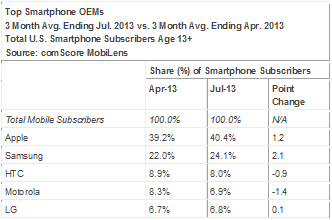
Sources
Appleinsider, comScore, Mashable, Nielsen
According to Nielsen, among recent acquirers in the US who got their smartphones within the last three months, 48% of those surveyed (in February 2013) said they chose an Android smartphone and 43% bought an iPhone; further proving Android’s dominance over iOS, even in Apple’s home market.
Source
Nielsen
Pew Research Center’s recent survey of the US market had similar findings, showing fully 28% of all cell phone owners use Android smartphones with 25% using an iPhone.
Sources
Pew Research Center, AppleInsider, Apple Insider
However, the battle is far from over as research also showed that Apple’s three-year-old iPhone 4 was the top choice for feature-phone switchers in the last 3 months in the US (according to Kantar Worldpanel). So although iOS’s smartphone market share may have taken a dent, its popularity shows no signs of waning and Apple may still bounce back to its #1 spot in the US smartphone market in the near future.
Source
VentureBeat
In the global smartphone market however, Samsung holds the #1 position, with a market share of 31.4% while Apple comes in 2nd place with 13.1% market share. 3rd place is held by Huawei at 4.8%, followed by Lenovo in 4th place (4.7%), then LG (4.6%) and others.
In terms of Mobile OS market share globally, Android leads with 79% market share, followed by iOS with 13%, then Windows Phone with 3.7% and others. IDC’s and Strategy Analytics’ numbers are slightly different but the market share conclusions are the same.
Sources
Gartner, IDC, Strategy Analytics
The following graphic shows the breakdown of Mobile OS market share in key markets across the globe.
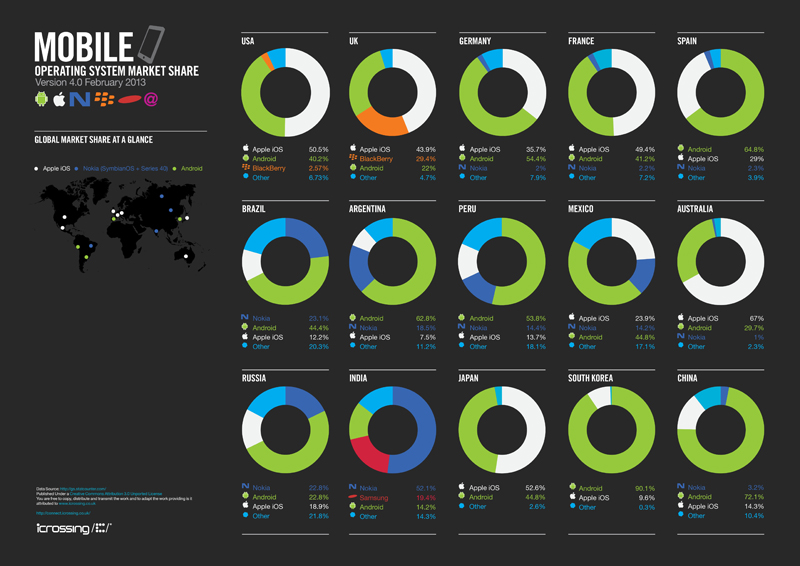
Source
Wallblog
However despite its dominance in the global smartphone market, the Android OS continues to be plagued by fragmentation, an issue that has dogged it since the very beginning. Google has not subject Android to the stringent oversight that Apple imposes on iOS – a practice that has ensured that iOS does not suffer from OS fragmentation issues.
Android device manufacturers are free use any version of Android they deem fit and as such, they typically tend to use older versions of Android in low cost devices and the latest version of Android only in their flagship models. Most Android device manufacturers also don’t provide updates for the Android OS installed on their lower end models (which are the biggest sellers by volume), thus resulting in a large number of Android devices being stuck on older versions of Android, resulting in OS fragmentation.
The following illustrations depicts the fragmentation level of Android, both at the device level and at the OS level.
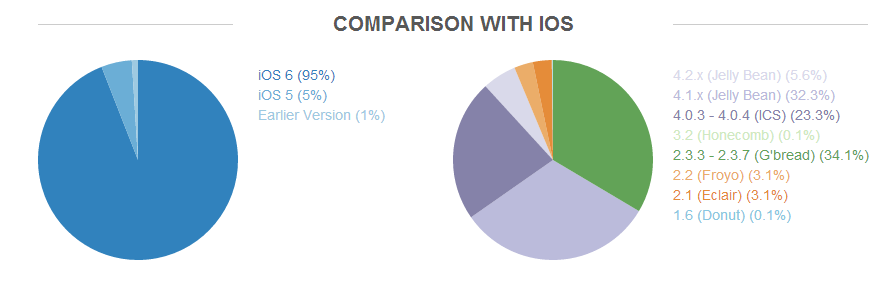
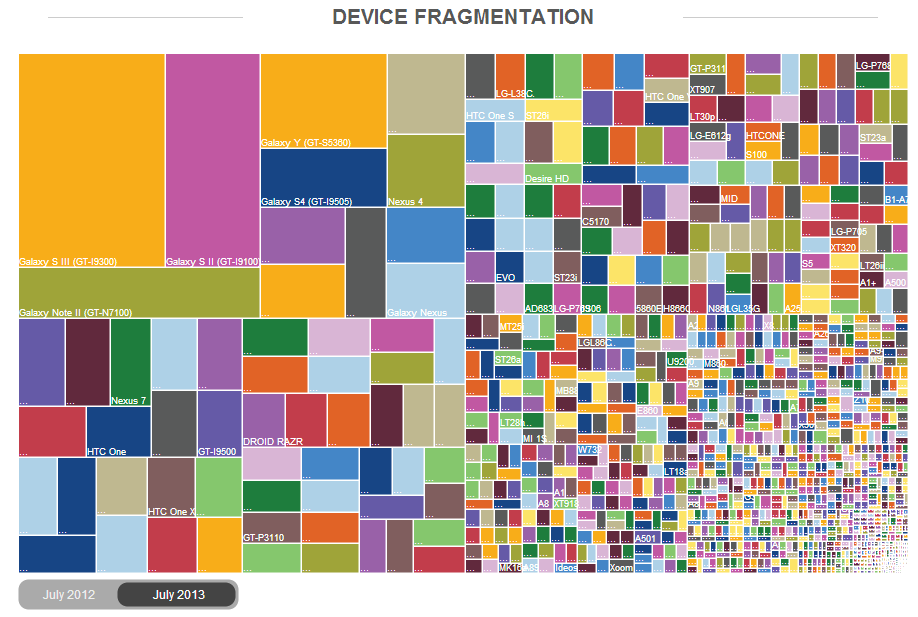
According to recent research, there were more 11000 distinct Android devices produced by various manufacturers this year, sporting various versions of Android. At present there are 8 different versions of Android in use, with Jelly Bean (which is the latest version of the OS) only available on 37.9% of Android devices.
Source
OpenSignal
In terms of smartphone market share by device, recent research by Millennial Media showed the Top 4 devices (by ad Impressions) to be the iPhone (at #1), the Galaxy S (at #2) and the iPad and iPod Touch at #3 and #4 respectively.
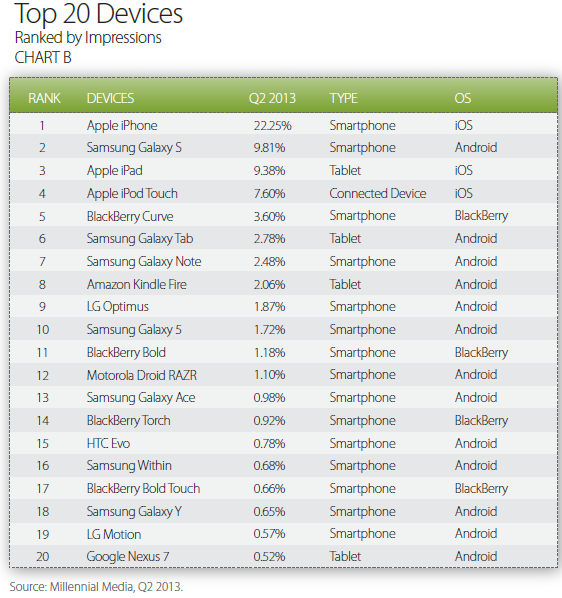
Looking at it from another perspective, i.e. in terms of number of devices sold, numbers from Wikipedia and ZDNet show that Samsung’s Galaxy S3 and Apple’s iPhone 4S share the #1 spot in terms of smartphone market share with more than 60M units sold to date, followed by the iPhone 4 at #2 (with 50M units sold) and the Galaxy S4 and S2 at #3 (with 40M units sold) and the Galaxy Note 2 at #4 (with 38M units sold) and the iPhone 3GS at #5 (with 35M units sold). Apple’s latest iPhone 5S comes in at considerably lower spot with 20M units sold.
In terms of devices popular in mobile gaming, particularly among Android mobile gamers, the latest figures from NativeX show the Android Device Market Share in the US to be as follows:
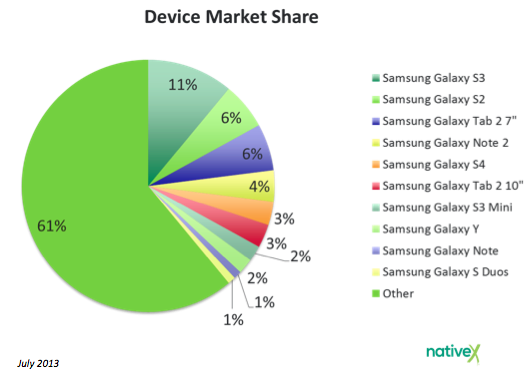

Source
NativeX
Windows Phone too has gained ground rapidly over the past few months, both in the US smartphone market as well as globally. In terms of smartphone market share in the US, here’s how Windows Phone devices are faring.
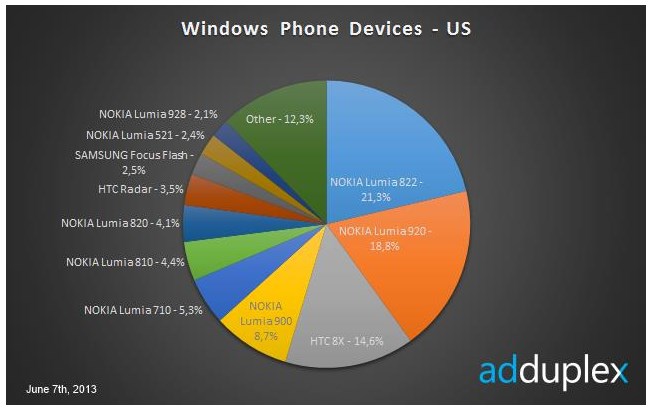
Source
TNW (The Next Web)
Globally too, Windows Phone seems to gaining momentum. According to Kantar Worldpanel, one out of every ten smartphone sold in Britain, France, Germany and Mexico is a Windows Phone device. Windows Phone also ranks at #2 in terms of smartphone market share in Mexico, taking in 11.6% of all smartphone sales in the country.
The surge in Windows Phone market share globally is driven largely by sales of Nokia’s Lumia smartphones, especially lower cost models such as the Lumia 520. Nokia recently posted record Q3 sales results, having sold 1.4 million Lumia smartphones in the US and 8.8 million devices globally.
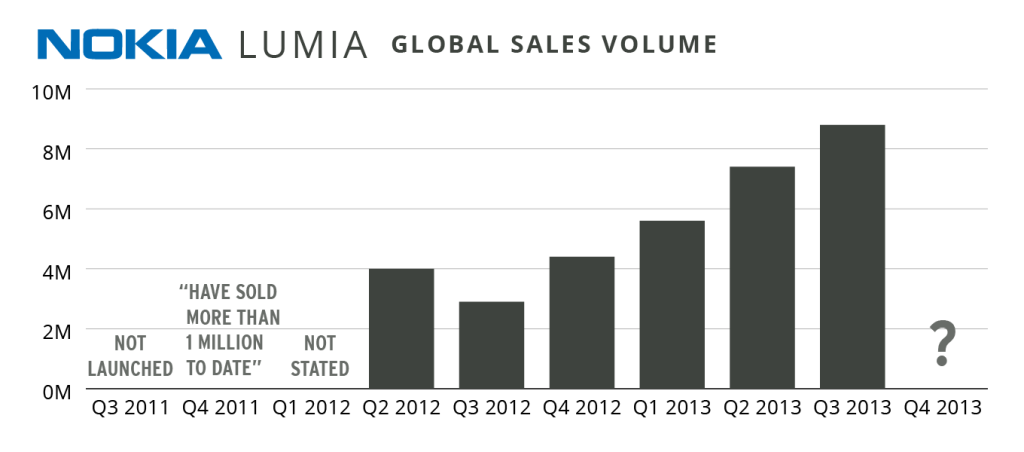
Sources
Tech Crunch, Kantar WorldPanel
With highly attractive budget device offerings like the Lumia 520, it’s not surprising that Windows Phone is the 2nd most used Mobile OS in Latin America (in Q2 2013).
Source
Windows Phone Central
Android Phablets have rapidly gone from a niche idea to a mainstream device. And since phablets first came out on Android (the Samsung Galaxy Note), the phablet market is mostly dominated by Android devices. In India, phablets (devices with a screen size of 5-7 inches) are even more popular than regular smartphones and hold 30% of the smartphone market share. This is driven by the booming sale of devices from Samsung like the galaxy Note and Note II and Sony’s Xperia Z Ultra and Xperia Z.
Source
The Economic Times
If the current trends persist, Android looks set to retain its #1 spot in the global smartphone market with iOS maintaining second place. As such mobile app and game developers should target their apps towards the most popular devices on these 2 platforms if they want get a good number downloads. The fragmentation issues on Android however do complicate things a bit, since you will need to develop your app for multiple Android versions and screen sizes in order to cater to the Android user base that’s split over all these devices.
And let’s not forget about Windows Phone. Given the sizable chunk of the smartphone market that Windows Phone now holds in North and South America and Europe, app and game developers would be wise to not leave out windows phone in their cross platform development efforts. With limited developer competition, the windows phone app store can propel early app entrants to app store leaders, a feat that be much more difficult to achieve later on down the road, as more developers get on the Windows Phone bandwagon.
As mobile app & game development specialists, Folio3 specializes in developing native & cross platform apps and games for the iPhone, iPad, Android and Windows Phone smartphones & tablets. For more information about our mobile app development services, please visit our mobile expertise page or check out our mobile development portfolio. If you have an app or game that you’d like develop, please get in touch with us.
USA408 365 4638
1301 Shoreway Road, Suite 160,
Belmont, CA 94002
Whether you are a large enterprise looking to augment your teams with experts resources or an SME looking to scale your business or a startup looking to build something.
We are your digital growth partner.
Tel:
+1 (408) 412-3813
Support:
+1 (408) 512 1812

COMMENTS ()
Tweet